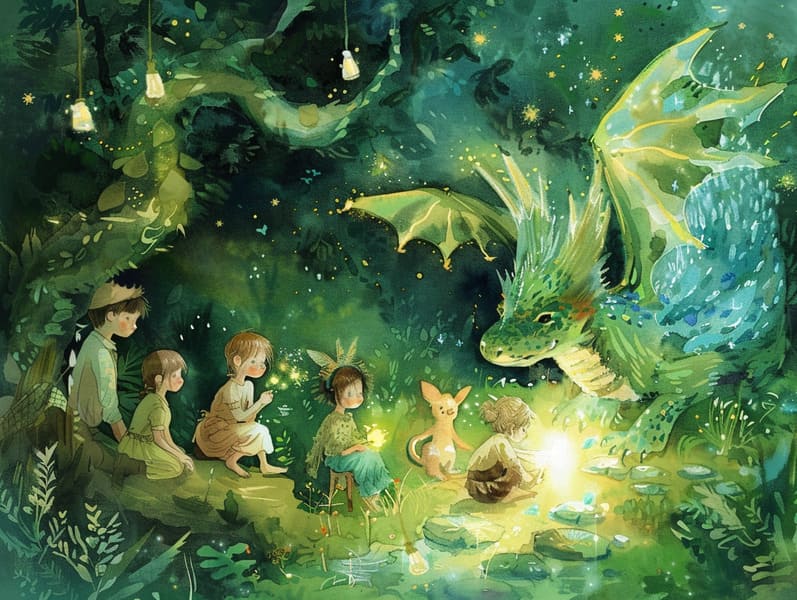
Popular fairy tales have deep roots. These narratives have been told from one generation to the next ages before they were ever put on paper. They were born from a variety of cultures, including Indigenous traditions. They were initially narrated among elders, often carrying themes and messages reflective of the societal norms and beliefs of the time.
The renowned Brothers Grimm, Jacob and Wilhelm, were among the first to gather many of these beloved narratives. Their published works, "Grimm's Fables," included stories like "Cinderella," "The Bread Crumb Trail," and "Snow White," which have since become cornerstones in the world of beloved fairy tales. Similarly, Hans Andersen's imaginative narratives, such as "The Sea Maid," and "The Story of the Ugly Duckling," have captivated hearts worldwide, cementing their place in the pantheon of beloved fairy tales.
Even though they are old, these stories remain as applicable as ever, especially as bedtime stories for kids. These whimsical stories are now available in many formats, including vividly illustrated books, whimsical animations, and digital fairy tales.
Their lasting appeal can be ascribed to several whimsical characteristics:
Crucial Morals: Ancient fairy tales often impart important moral lessons. Tales like "The Wolf and the Liar" teach the merit of truthfulness, while "The Story of the Tortoise and the Hare" illustrate the values of steadfastness and unpretentiousness. These tales offer kids clear distinctions between ethical and unethical, developing their moral compass in a mild yet profound way.
Empathy and Understanding: Traditional fairy tales frequently feature protagonists facing obstacles and hardships, urging readers to resonate with their struggles and celebrate their triumphs. For instance, "The Tale of Beauty and the Beast" illustrates the virtue of appreciating inner worth to acknowledge the true nature of a character, nurturing tenderness and comprehension.
Cultural Knowledge: Many traditional fairy tales are infused with the cultural contexts from which they grew. Understanding these narratives can provide delightful insights into different societies, encouraging a sense of international awareness and knowledge.
Inventiveness and Imagination: The enchanted elements in traditional fairy tales—mythical creatures—foster children’s dreams. These tales bring readers to magical realms, generating imaginative dreams and a sense of excitement that continues a lifetime.
Traditional fairy tales are not only captivating but also teaching. They serve as fascinating tools in building various mental and emotional abilities in young readers. When classic fairy tales are told out loud, they enhance language acquisition by offering new terms and complex sentence structures. This practice also develops auditory skills and attention span, as the young hang on every word, keen to see what happens next.
Furthermore, reflecting on the themes and characters of fairy tales can strengthen logical thinking and thought processes. Little ones are educated to discover patterns, expect results, and make sense of cause and effect. These talks also encourage young readers say their thoughts and feelings, strengthening their emotional intelligence.
In today’s digital era, the prevalence of free fairy tales online has made these fairy tales more available than ever. Web-based platforms and mobile apps present extensive collections of bedtime fairy tales that can be enjoyed or listened via anytime, anywhere. Fairy tales spoken are particularly sought after, featuring an interactive way for the young to relish these spellbinding stories. Audio stories and narrated videos transport characters and settings to life, often supplemented by whimsical soundtracks and harmonies that elevate the story adventure.
The timeless fascination of old fairy tales lies in their ability to adapt to new eras while maintaining their key morals. Contemporary reinterpretations of these stories often spotlight more multicultural protagonists and modern settings, making them relatable to today’s audience. However, the basic principles of bravery, sympathy, and integrity remain unchanged, continuing to impact children of all ages.
Classic fairy tales also offer a sense of serenity and predictability. They make available a well-structured narrative with a evident beginning, middle, and end, often closing with the wrap-up of conflicts and the triumph of morality over immorality. This predictability can be calming for young readers, spreading a sense of unchangeability in an unpredictable world.
Classic fairy tales continue to mesmerize and train new generations, maintaining their magic and importance in modern society. As children's bedtime stories, they put forth a perfect blend of charm and understanding, enhancing moral values, empathy, and creativity. The prevalence of online storybooks and the well-received status of fairy tales told out loud ensure that these traditional fairy click here tales remain attainable to new generations.
By sustaining and telling these tales, we continue to praise the rich tapestry of inventiveness and cultural heritage. Whether you are delving into a artistically illustrated book, delving into a cyber collection, or listening on an sound book, the allure of old fairy tales is always within reach. These narratives highlight of the ageless magic of tales and its ability to tie us across time and space.
Whether you are enjoying a beautifully illustrated book, seeing a online library, or listening on an audiobook, the grace of famous fairy tales is always within reach.
These narratives highlight of the timeless strength of storytelling and its ability to link us across generations and cultures, making a tie that fascinates and enlightens alike.